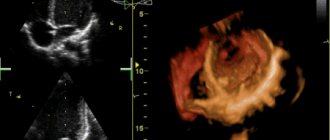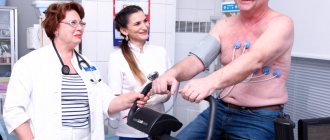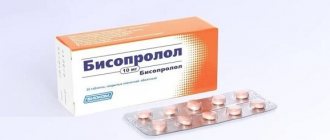: March 21, 2021, Masters of the Heart, volume 73, no. 1
A huge role in the life of our body is played by the autonomic (autonomous) nervous system, which, like an octopus, has spread its “tentacles” throughout the body. Innervating internal organs such as the heart, intestines, endocrine glands, etc., based on feedback, it regulates the most important functions of the body, from breathing to reproduction. Many cardiovascular pathologies are associated with disruptions in the functioning of this system. Specialists of the Center for Interventional Cardiology of the Siberian Federal Biomedical Research Center named after. acad. E. N. Meshalkina was one of the first in the world to use minimally invasive technology for the treatment of ventricular arrhythmias by blocking nerve impulses coming from the kidneys
A healthy heart beats in a certain rhythm that corresponds to the physiological state of the body. However, diseases of the cardiovascular, nervous and endocrine systems, as well as severe stress, excess weight, alcohol and smoking abuse, and even a drop in potassium levels in the blood, can cause a whole range of cardiac disorders, from arrhythmia to extrasystole, characterized by extraordinary contractions.
Arrhythmias are divided into groups depending on in which part of the heart the malfunctions occurred: in the atria, the sinus-atrial node (the “driver” of the heart rhythm) or the ventricles, which play the role of a pressure pump. Most of these disorders are closely related to the state of the autonomic nervous system, which regulates the activity of all internal organs.
Ventricular heart rhythm disturbances can be either congenital or acquired. For example, they may be a consequence of a structural pathology of the heart - a scar that appears as a result of myocardial infarction. In any case, they are life-threatening types of arrhythmia and, without emergency medical care, can cause sudden death.
What is the essence of renal denervation?
The kidneys play a key role in regulating blood pressure. Medicines that lower blood pressure affect the renal mechanisms to varying degrees. But in some cases, even a combination of three or four drugs with different mechanisms of action does not allow normalization of blood pressure. In such cases, they speak of refractory arterial hypertension. It turned out that in refractory hypertension, maintaining a high level of blood pressure occurs due to the excessive release of norepinephrine, a hormone that increases hypertension. The nerve cells that produce norepinephrine are found in the arteries that supply blood to the kidneys. If the activity of these cells is suppressed, blood pressure normalizes.
Radiofrequency ablation (denervation) of the renal arteries without taking into account the cost of consumable instruments - 60,000 - 120,000 rubles.
Denervation of the renal arteries using a Vessix catheter - RUB 250,000.
Included in the price:
manipulation, hospital stay, dressings, postoperative observation by the attending physician, medications and nutrition
20-30 minutes
(duration of procedure)
1 day in hospital
Indications
- refractory arterial hypertension, i.e. inability to achieve the target blood pressure level (BP below 140/90 mm Hg), despite taking three or more antihypertensive drugs, including diuretics;
- a large number of medications taken by a patient with arterial hypertension for other diseases;
- inability to adequately take medications to reduce arterial hypertension due to side effects.
Contraindications
- allergy to iodine-containing contrast agent;
- pregnancy;
- severe renal failure;
- acute inflammatory diseases.
Main results
- Patients who underwent renal denervation showed a statistically significant decrease in daytime, nighttime, and 24-hour SBP compared with the control group (mean difference, -6.0 mmHg)
- The smoothing index was significantly higher in patients in the renal denervation group (1.4 ± 1.2) compared with the control group (0.9 ± 0.6, P = 0.02), while no statistically significant differences were found in the standard deviation of SBP , DBP, stiffness index and percentage of non-dippers.
- The number of patients who responded to therapy was significantly higher in the study group (44.5% vs. 20.8%; P=0.01).
- The number of patients with isolated systolic hypertension did not differ significantly between responders and non-responders to treatment (25% vs. 37%).
- In stepwise discriminant analysis, baseline mean nighttime SBP and standard deviation of nighttime SBP were significant predictors of treatment response (P=0.005).
- Area under the curve (AUC) was 0.65 (95% CI: 0.486–0.816; P=0.07) for baseline mean nighttime SBP and 0.72 (95% CI: 0.565–0.874; P=0.005) for baseline mean nighttime SBP deviation time.
- For the initial average SBP at night, the threshold is 136 mm Hg. Art. was the best compromise between sensitivity (75%) and specificity (54%) for predicting response to therapy.
- For the standard deviation of SBP at night, the threshold is 12 mmHg. Art. was the best compromise between sensitivity (55%) and specificity (83%) for predicting treatment response.
Reviews of doctors providing the service – Denervation of the renal arteries
I had surgery on 2 legs with Yuri Stanislavovich Malakhov.
I want to express my deep gratitude to him for a new breath of life, lightness on my feet, one might say, a completely different standard of living. Yuri Stanislavovich, you have golden hands and you are a doctor from God! I recommend it to everyone, women and men - don’t be afraid and... Read full review Irina Nikolaevna G
11.06.2021
I would like to sincerely thank the surgeon-phlebologist Yuri Stanislavovich Malakhov for the high-quality treatment of varicose veins using a modern method: no incision, no hospitalization, high cosmetic effect. The very next day I went to work. Yuri Stanislavovich is a professional... Read full review
Natalia Viktorovna F
18.04.2021
Treatment options for resistant arterial hypertension
Today, a cardiologist has about 40 antihypertensive drugs in his arsenal, however, even when rational combinations are used, it is not always possible to achieve target blood pressure.
Even with rational pharmacotherapy, target blood pressure can be achieved in no more than 35% of patients. The exact prevalence of resistant hypertension is unknown. According to large centers, its frequency can reach 10–13% [4, 5], and this figure remains high even after excluding pseudo-resistant hypertension associated with “white coat” hypertension, errors in blood pressure measurement, etc.
For many years, the only way to normalize blood pressure in patients with true resistant hypertension was the prescription of polypharmacotherapy with the simultaneous use of 4–6 or more drugs. However, such treatment tactics often led to the development of serious side effects.
As is known, the sympathetic nervous system (SNS) is one of the main pressor mechanisms, and its activation is a key factor in the development of essential hypertension. Hyperactivation of the SNS and a progressive increase in blood pressure mutually reinforce each other and participate in the formation of a vicious circle. Increased activity of the SNS most affects the kidneys. With hyperactivation of the SNS in the kidneys, vasoconstriction occurs, blood flow and filtration decrease, renin secretion increases, and sodium and water reabsorption increases. Afferent impulses from the kidneys enter first the lateral horns of the spinal cord, and then to the vascular center in the central nervous system, contributing to an increase in blood pressure. It increases with stretching of mechanoreceptors, renal ischemia, and under the influence of hypoxia [6].
The search for non-drug methods of treating hypertension, allowing to control the effects of the SNS and regulate its excessive activity, has been going on for quite some time. Manipulation of the sympathetic nerves as one of the types of treatment tactics was considered even before the advent of modern antihypertensive pharmacotherapy. Radical surgical methods of thoracic, abdominal and pelvic sympathetic denervation, and later partial sympathectomy, were relatively successfully used to lower blood pressure in patients with so-called malignant hypertension in the first half of the 20th century. However, these operations were associated with high mortality and the risk of complications both immediately after the intervention and delayed ones, including gastrointestinal dysfunction and pelvic disorders [7–9]. It is not surprising that with the advent of effective antihypertensive drugs, such surgical interventions have become very unattractive for both doctors and patients.
At the beginning of the 21st century, researchers again turned to the idea of influencing the renal sympathetic nerves, but using minimally invasive technologies.
How is renal denervation performed at the CELT clinic?
The procedure is performed without anesthesia, with local anesthesia. In this case, a special catheter in the form of a balloon is inserted through a puncture of the radial or femoral artery under angiographic control, on which point electrodes are located. The essence of the procedure is short-term radiofrequency destruction (ablation) of cells that secrete norepinephrine. The balloon is inserted into the trunk of each renal artery in turn, delivering high-frequency wave energy. The high-frequency impulse destroys the fibers of the nerves passing through the wall of the vessel, as a result of which irritating impulses do not reach the brain, and blood pressure is normalized. The duration of the intervention is 20-30 minutes. The patient can leave the hospital on the same day.
The way to the heart is through the kidneys
Today, ventricular arrhythmias are treated medically or surgically through elective open-heart surgery. For example, when performing coronary artery bypass surgery, the post-infarction scar that causes arrhythmia is also removed. When using a minimally invasive radiofrequency ablation method
A special catheter is inserted into the left ventricle, using special imaging systems, areas causing arrhythmias are identified and destroyed by applying high-frequency electric current.
However, 10–20% of patients suffering from ventricular arrhythmias are not helped by any currently known treatment methods. The fact is that a scar on the heart can have a very complex structure, and then even the most advanced medical navigation system, which determines the internal contour of the heart with millimeter accuracy, cannot accurately indicate the pathological zone.
Since the 1990s. such patients are implanted under the skin in the upper part of the chest with a special electronic device - a cardioverter-defibrillator
, connected to a system of electrodes in contact with the heart. This emergency “watchman” for arrhythmia not only monitors the rhythm of contractions, but also generates life-saving shock electrical discharges in the event of an arrhythmia. But this method does not relieve a person from the disease, but only prevents its fatal consequences. In addition, frequent electrical impulses make the heart muscle flabby, hastening the development of heart failure.
Nevertheless, a way out of this seemingly dead-end situation was found. renal denervation, began to be introduced into clinical practice.
, proposed by M. Levin and D. Gelfand in 2003. And a few years later, the first publication on clinical renal denervation was published (Krum
et al.
, 2009).
The essence of this method is to interrupt the conduction of nerve impulses along the fibers of the autonomic nervous system, which pass not to the heart, but directly to the kidneys. Located in close proximity to the renal arteries, the nerves form the so-called perivascular plexuses
. During the renal denervation procedure, a special balloon is inserted into each renal artery through a puncture in the femoral artery, on the surface of which there are electrodes that block the lumen of the vessels. A series of radiofrequency electrical pulses with a power of 0.5–1.0 W is applied to the electrodes for 30 s. The temperature in this place rises to 70 °C, and this thermal effect blocks the conduction of nerve impulses along the nerve fibers passing along the upper vascular walls.
This method was first used to treat patients with arterial hypertension. Experiments have shown that interrupting the nerve impulses of the autonomic nervous system coming from the kidneys, signaling the brain about increased vascular tone and an increase in blood pressure, leads to a decrease in the latter. Left without feedback from the higher brain center, the kidneys begin to “think” that the pressure is actually normal. As a result, the parameters of the renin-angiotensin-aldosterone system
– a set of enzymes and hormones involved in the regulation of water and electrolyte balance.
Ultimately, the brain begins to receive signals that everything is fine with the pressure, and it, in turn, “agrees.” In essence, the result is achieved by interrupting the pathological feedback, in which the kidneys and the brain mutually “spur” each other with information that “everything is bad.”
Indications for surgery
- Spondyloarthrosis. The most common cause of chest and neck pain is the facet joints. In treatment, injections are ineffective, they act for a short time or give partial results. RFD of the spine in this case is the preferred manipulation, blocking pain for a longer time.
- Discogenic pain. Its spread most often occurs in pathology of the lower spine, when the patient feels severe pain in the affected area, transmitted to the arms and legs. The situation is complicated by limited mobility. The use of RFD in such cases shows effectiveness if surgical intervention is not required.
- If the cause of pain is spinal stenosis, the use of RFD is the most effective and preferred measure.
- Pain in the coccyx area can also be relieved by RFD of the coccygeal nerve.
- Severe constant or paroxysmal headache.
Denervation of kidney blood vessels in Israel: prices
The cost of medical services in the clinic is calculated individually for each patient, after a full examination and consideration of treatment recommendations.
At the same time, you will be pleasantly surprised by our prices. Israeli medicine is 30-50% cheaper than in Europe, Canada and the USA. You can pay for the procedures in stages, as the treatment progresses. If you now want to find out how denervation of the blood vessels of the kidneys will go in your case in Israel, the approximate cost of the operation, you can contact our consultant - leave a request or request a call back.
- Aortic stenosis
- Arterial hypertension
Advantages of treatment at Top Ikhilov
- Top Ichilov doctors thoroughly master the technique of cauterizing renal blood vessels and have cured thousands of patients from hypertension in this way.
- Israeli clinics are equipped with the latest technology, which ensures 100% correct diagnosis and the highest quality of surgery.
- Israeli doctors realize that a correctly established diagnosis is the main stage of successful treatment. Therefore, examinations in Israeli clinics are honed to perfection.
- Prices for surgery at Top Ichilov are an economical option among other clinics in Israel. Moreover, the cost of medical services in the Promised Land is 30-50% lower than in European countries and the USA.
- Functions of the international department: employees will take care of all issues related to arrival, accommodation, translation of medical documentation, 24-hour support.
- You can read or watch video reviews on our website about how denervation of the blood vessels of the kidneys takes place in Israel, patient reviews.
- 5
- 4
- 3
- 2
- 1
(7 votes, average: 4.6 out of 5)
Rules for preparing for RFD
Obtaining positive dynamics largely depends on a complete preoperative examination, which includes:
- X-rays of light.
- neurologist's report;
- MRI;
- general blood and urine test, blood test for RW, hepatitis, HIV;
- ECG.
Radiofrequency denervation of joints requires the following precautions:
- some restrictions on food intake - you can’t eat for eight hours before the procedure and drink for two;
- when using insulin, the dose administered on the day of the procedure should be adjusted;
- the decision to stop taking medications is made by a specialist;
- there is a need to refrain from driving vehicles for 12 hours after the procedure.
Efficiency of the procedure
The therapeutic effect of the procedure is noticeable immediately, the pain syndrome disappears. The final result can be assessed after one and a half months, since in some cases effectiveness appears only after this period.
The effectiveness of such treatment in various cases can last up to several years. In many cases, the patient needs to engage in physical therapy to restore and develop the joint. If pain relief is not provided, a person will not be able to exercise - the pain will not allow him to move normally. After the procedure, patients begin to exercise, which helps avoid surgery altogether or postpone it for a long time.
If the necessary measures are not taken in a timely manner, pain will become a constant daily test for a person, and there can be no talk of an active lifestyle at all, because even the simplest movements will be difficult.









